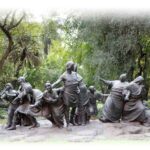Saturnalia, celebrated from December 17 to 23, is an ancient Roman festival and holiday held to celebrate the agricultural god Saturn. It was the most popular holiday on the ancient Roman calendar and was derived from older farming-related rituals of midwinter and the winter solstice. It was the liveliest festival of the year with sounds of merriment and preparation everywhere; it would be very difficult not to take notice of the Saturnalia celebrations even if you were new to the environment, as the people took it very, very seriously. During this time, normal social patterns came to a halt. Feasting, gifting, singing, dancing, games, gambling, decorations, and role-reversals were the usual activities, so on this day, businesses, schools, courts, and other forms of work would stop so that everyone could join in the fun; it was the best of days. “Io saturnalia” is the salutation during this season, so whenever you hear this greeting, know that there is excitement in the air and it is in honor of the god Saturn.
History of Saturnalia
The pagan celebration of the Roman god, Saturn, first began as a single day, but later extended to a whole week during the late Republic. The festival began on December 17 of the Julian calendar, which the Romans used in those days, and initially ended on December 25, the time at which the winter solstice fell. During the celebration period, all activities came to a halt. Businesses, courts, schools, and other social patterns were suspended while people spent time doing more fun activities. Slaves were allowed to take part in the celebration and even reversed roles with their masters. Feasting, playing, gambling, singing, exchanging gifts and home decorations were some of the activities people enjoyed doing during this time. Thus, the Saturnalia celebrations are the source of many traditions associated with Christmas.
During Saturnalia, celebrations were held not only at home but also in the temple of Saturn in Rome. In the fourth century, the temple was constructed in place of an older temple. On the first day of the Saturnalia celebrations, a young pig would be sacrificed publicly. Also, during the celebrations, the woolen bonds tied around the feet of the cult statue of Saturn were loosened to signify the god’s freedom. Numerous archaeological sites from the Roman coastal province of Constantine, now in Algeria, demonstrate that the statue of Saturn survived there until the early third century.
In wealthier Roman households, the aturnalicius princeps or “leader of Saturnalia” were selected from among the slaves. This person was known as the mock king and was responsible for organizing merrymaking and mischief during the celebrations. He was seen as the ruler of chaos, in direct contrast to the normal orderly manner of Roman life; he was also in charge of making offerings to the Roman household gods associated with domestic life (penates). Other common holiday customs such as hiding coins or other small objects in cakes date back to earlier Saturnalia practices, as it was a way used to choose the mock king in those days.
Western culture of today derived many of its traditional midwinter celebrations from Saturnalia. The Christmas holiday owes most of its practices to Saturnalia, including the time of the year at which it is celebrated. Theologians decided that Jesus was most likely born in spring and the Bible also does not give a date for the celebration of his birth. The older seasonal celebrations practiced by the Celts and other groups were suppressed by the Roman empire’s conquests in Britain and the rest of Europe beginning from the second century B.C. and ending in the fourth century A.D. During this time, the Church settled on celebrating Christmas on December 25 and incorporated it with Saturnalia and other midwinter traditions. The pagans and Christians lived together during this time, and this might have represented an effort for the pagans to receive Christianity as Rome’s official religion.
Saturnalia timeline
This marks the dedication anniversary of the Temple to Saturn in the Roman Forum.
From at least as early as 217 B.C., there were public Saturnalia banquets.
The conversion of Constantine to Christianity ended the Roman persecution of Christians.
Saturnalia FAQs
How long does Saturnalia last?
Saturnalia was originally celebrated on December 17 before it was extended to three days and eventually seven days.
What is the symbol for Saturn?
The symbol for Saturn is thought to be an ancient scythe or sickle, as Saturn was the god of seed-sowing.
Is the Christmas celebration also Saturnalia?
Christmas is not Saturnalia, but Christmas originated from Saturnalia. Romans spend Saturnalia much like how we spend Christmas; feasting, drinking, gift-giving, and being joyful. After the conversion of the Roman emperor to Christianity, the church elders sought a more solemn celebration for their Christian followers.
Saturnalia Activities
Wear the colors of the day
The colors are green and gold. Wearing these colors sends a message that you are in the mood for the season.
Try out symbols
Try making snacks into the shapes of sun, moon, stars, herd animals, and fertility symbols. For example, you can cut your cookies into these shapes before baking during Saturnalia.
Do some decoration
Decorate over doorways, windows, and stairs with greenery. Although garlands or wreaths are ideal, you can also add golden cutouts of the sun or golden pinecones, nuts, or acorns.
5 Interesting Facts About Saturnalia You Didn’t Know
Pork was the favorite Roman meat
Live pigs and pork sausage were given as gifts during Saturnalia.
Io Saturnalia
(pronounced "EEyo-sa-tur-NAH-ee-uh) was how the Romans greeted each other during the celebration period.
Slaves enjoyed luxury
Saturnalia was also a time to celebrate freedom and destroy hierarchies; during this period, slaves could enjoy luxury alongside their masters.
Saturnalia began as a farmer's festival
This was to mark the end of autumn planting in honor of Saturn, the god of agriculture.
Activities cease during Saturnalia
All schools, courts, and businesses were halted.
Why We Love Saturnalia
It is a time to receive gifts
Giving gifts was the most important aspect outside of the public feast – signillaria (small wax or pottery figurines, which some think became the toys we give out today). Signillaria could be quite expensive depending on their ornateness; cheaper gifts like dice, writing tables, combs, and tools were also given. Everyone looked forward to this time.
It strengthens bonds
Saturnalia gave people time away from all forms of work activities. This made it a good time to reunite with distant family, relatives, and friends.
It was a time to rest and have fun
The celebration period gave people time to relax and enjoy themselves. What better way to celebrate?
Saturnalia dates
| Year | Date | Day |
|---|---|---|
| 2025 | December 17–23 | Wednesday–Tuesday |
| 2026 | December 17–23 | Thursday–Wednesday |
| 2027 | December 17–23 | Friday–Thursday |
| 2028 | December 17–23 | Sunday–Saturday |
| 2029 | December 17–23 | Monday–Sunday |







